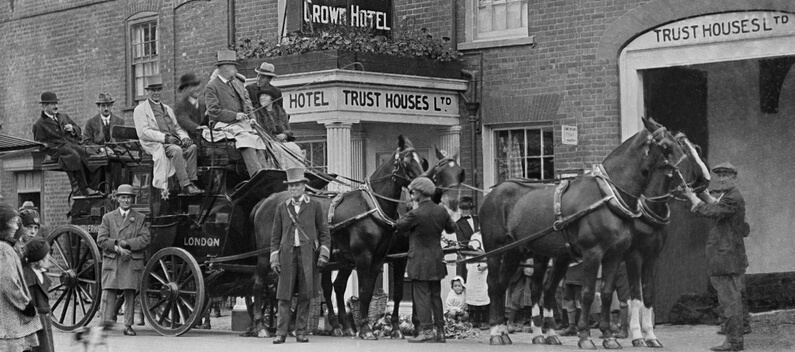There are 6 pubs today, but there were at least 5 more – the Red Lion, the Wheatsheaf (in London Road), the Hare & Hounds (in Whielden Street), the Griffin which became a restaurant a few years ago and the Nag’s Head in Whielden St – now another restaurant. In the 17th century there were three more inns: White Hart (The Worthies), The George (Tresco House) and the Queens Head (“alehouse by the Market House”, possibly now part of The Crown).
This was written by “A.E.P.M.” and taken from the January 1981 Amersham Society News
The many historic inns of Old Amersham suggest a long tradition of hospitality to strangers. A day’s ride north-west of London, the town was a natural resting place for men and horses. An early reference to an inn is dated 1541, when ‘Dorset of the White Hart’ gave money towards mending the church wall, but it is unlikely that the White Hart was the only hostelry in this flourishing Tudor market town.
In the reign of Charles 1, Buckinghamshire had the largest number of carrier services per week from London – 33 as compared with 19 to Northamptonshire, the next busiest County. Some of this traffic would have gone to High Wycombe, some to Stony Stratford, via Hertfordshire, but much obviously passed along the Misbourne Valley en route for Aylesbury. The ‘Carriers’ Cosmographie’ of 1637, listing four London inns where the Aylesbury carriers lodged, states “They are at one of these places every other day”. Carriers must have been a familiar sight trudging through Amersham with their wagons or pack horses, needing food and a rest before the last lap to Aylesbury.
Although civil war disrupted trade generally, troop movements kept Amersham victuallers busy. Parliamentary soldiers are said to have been quartered at The Griffin, which Oliver Cromwell may have dined their somewhat later. After the Restoration, Buckinghamshire had a much smaller share of the nation’s carrier services but the era of the turnpike road and stage coaches had begun and Amersham was soon catering for an increased volume of passenger traffic.
The 1712 will of William Hailey, landlord of the ‘Saracens Head’, suggests that innkeeping was a profitable trade. Hayley’s father had been a labourer in 1635 but 77 years later, innholder William left his heirs two houses, three cottages, a meadow and substantial cash bequests.
By 1737, two stage coaches passed through Amersham daily on the London to Aylesbury run, and later the route was extended via Buckingham and Stratford-on-Avon to Shrewsbury. Early directories list the ‘Griffin’ for ‘coaching’ and the ‘Crown’ for ‘posting’. In 1742 The Crown belonged to Mrs Drake, the Squire’s lady, and the landlord was Charles Fowler whose family ran the inn for some 90 years. The Swan was another major coaching inn but The Kings Arms, despite its modern picture-postcard appeal, was probably little more than an alehouse.
In 1773, 16 licences were granted to innkeepers, alehouse keepers and victuallers in Amersham parish. At least half these houses were within a stone’s throw of the Market Hall. The Griffin, Crown, Kings Arms and Swan were on the south side of the main road, with the ‘Hare and Hounds’ (now vanished) and the ‘Saracens Head’ round the corner in Whielden Street. North of the highway was The Chequers and also listed was a Spread Eagle which may have lost the adjective at some later date. The 18th Century licensing records do not mention The Elephant and Castle, although the building is old.
Later in the 1770s, the name of The Red Lion appears (now Su Chases on the north side of the High Street). It has been suggested that a dance floor here indicates that it was intended for use as an Assembly Room but despite this aspiration to gentility, The Red Lion never achieved more than ‘beer retailer’ status in the 19th Century directories. The Wheatsheaf flourished at Bury End in Victorian times but like The Hare and Hounds and The Red Lion has since closed. The Nag’s Head (now Prezzo) was in use by the 1890s.
The railway boom of the mid-19th Century spelt disaster to many towns which had grown up with the coaching trade. But Amersham was luckier than most in possessing an alternative source of employment. William Weller had taken over the brewery beside the church in 1771 and by the end of Victoria’s reign more than half the townsmen worked there. A high proportion of their wages probably went back to the brewery via the pubs, for when Wellers sold up in 1929 they owned 142 licensed premises in Buckinghamshire, Hertfordshire and Middlesex. Their local houses included The Kings Arm, Eagle, Chequers, Saracen’s Head, Wheatsheaf, the Queen’s Head at Whielden Gate, the Old Griffin at Mop End, The Boot and Slipper, Station Hotel (later the Iron Horse, now demolished) and The Red Lion in the High Street, plus two other pubs of the same name in Coleshill and Chestnut Lane. Only The Crown, Griffin and Swan, the grand old ladies of the coaching age, had survived the great Weller take-over.

